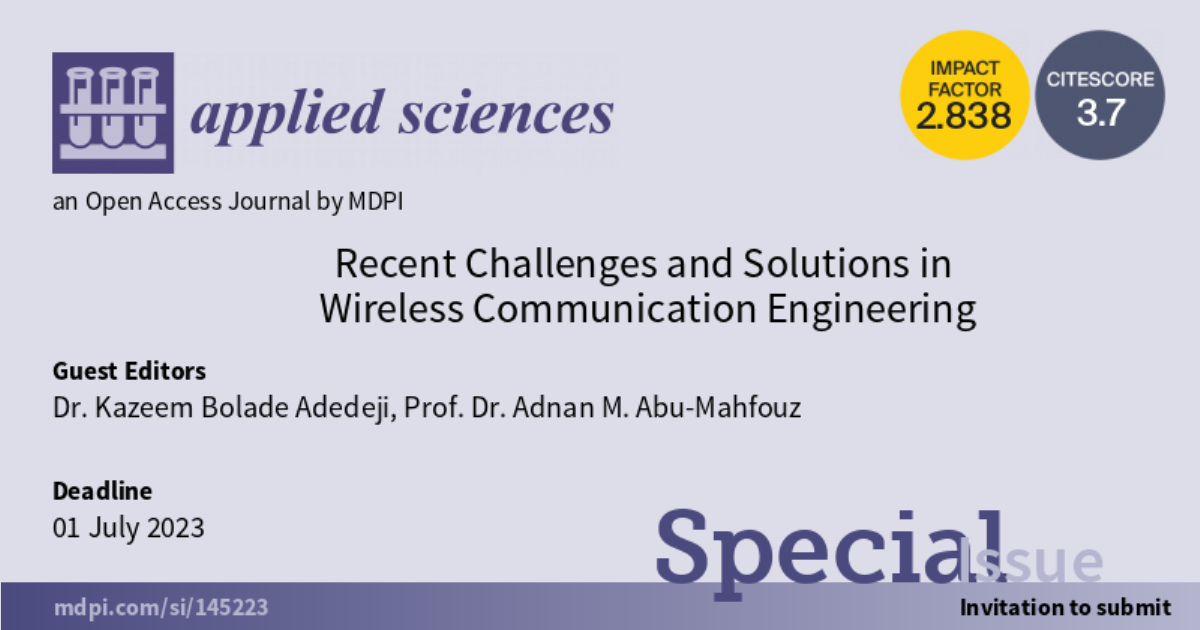Recent Challenges and Solutions in Wireless Communication Engineering
A special issue of Applied Sciences (ISSN 2076-3417). This special issue belongs to the section "Electrical, Electronics and Communications Engineering".
Deadline for manuscript submissions: closed (1 July 2023) | Viewed by 4889

Special Issue Editors
2. Department of Electrical and Electronics Engineering, The Federal University of Technology, Akure, Ondo State, Nigeria
Interests: communication security; wireless sensor network; IoT; instrumentation and electromagnetic compatibility
Special Issue Information
Dear Colleagues,
The growing demand for extremely high-data-rate services, together with the emerging Internet of Things (IoT), brings new technical challenges to wireless communications. While accommodating fast-growing enhanced multimedia services, future wireless systems need to simultaneously support the communication demands of massive IoT devices. IoT applications need wireless communications for various linked devices that are extremely reliable, low-latency, and energy-efficient. Future wireless communication systems should use novel network structures, spectrum access plans, and resource allocation strategies while taking energy efficiency and security into account to support a universal and pervasive cyber-physical infrastructure for a wide range of applications. In recent years, IoT has emerged as one of the enabling wireless technologies and has been deployed in different areas of engineering. Since an IoT-based system would consist of potentially millions of nodes using wireless technologies to communicate, they have more security risks and are prone to numerous cyber attacks due to the open nature of wireless media. One of the most perilous threats on the internet is the Denial of Service (DoS) attack. It has been reported that there will be more than 17 million DoS attacks carried out by 2022. However, once the source of the attack is determined, it is easy to defend the system by blocking the traffic coming from the attacking site. Furthermore, antennas are fundamental elements in wireless communications. Research into ultra-wideband antenna designs for wireless applications has been increasing due to their potential to cover large frequency bands. Additionally, the modern-day advancement in multimedia applications requires that the devices used in wireless communication be more sensitive, compact in size, low in price, and simpler. The demand for higher data rate communication, saturation of the frequency spectrum and low power consumption are some of the reasons why ultra-wideband has been of increased research interest over the past few years. Unfortunately, the UWB system covers an extremely wide band of 3.1 to 10.6 GHz for both indoor and outdoor handheld applications, which is being used by some other narrowband applications. Consequently, interference from other narrowband applications within the frequency spectrum in the UWB system is a crucial issue to tackle. This Special Issue seeks cutting-edge, high-quality research papers that describe practical and theoretical solutions to wireless communication systems and network security. Potential topics include but are not limited to:
- Internet of things and Industrial IoT;
- Attack detection and mitigation in IoT system;
- UWB patch antenna design and analysis;
- Energy efficiency optimization in wireless sensors networks;
- Dynamic spectrum allocation and resource optimization;
- Wireless access technologies;
- Interference management for 5G and future wireless technologies;
- Security enhancement for future wireless technologies;
- Dependability and resilience in wireless networks;
- Multiuser and mm-wave MIMO;
- AI for wireless sensing;
- Machine learning algorithms and implementation over wireless communication networks;
- AI for physical layer security;
- AI and machine learning for congestion control;
- Intelligent network visualization and software defined networking;
- Semantic communications for the metaverse;
- Integrated sensing and communication for 6G.
Dr. Kazeem Bolade B. Adedeji
Prof. Dr. Adnan M. Abu-Mahfouz
Guest Editors
Manuscript Submission Information
Manuscripts should be submitted online at www.mdpi.com by registering and logging in to this website. Once you are registered, click here to go to the submission form. Manuscripts can be submitted until the deadline. All submissions that pass pre-check are peer-reviewed. Accepted papers will be published continuously in the journal (as soon as accepted) and will be listed together on the special issue website. Research articles, review articles as well as short communications are invited. For planned papers, a title and short abstract (about 100 words) can be sent to the Editorial Office for announcement on this website.
Submitted manuscripts should not have been published previously, nor be under consideration for publication elsewhere (except conference proceedings papers). All manuscripts are thoroughly refereed through a single-blind peer-review process. A guide for authors and other relevant information for submission of manuscripts is available on the Instructions for Authors page. Applied Sciences is an international peer-reviewed open access semimonthly journal published by MDPI.
Please visit the Instructions for Authors page before submitting a manuscript. The Article Processing Charge (APC) for publication in this open access journal is 2400 CHF (Swiss Francs). Submitted papers should be well formatted and use good English. Authors may use MDPI's English editing service prior to publication or during author revisions.
Keywords
- energy efficiency
- IoT
- multimedia service
- security
- UWB
- wireless system





